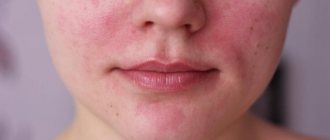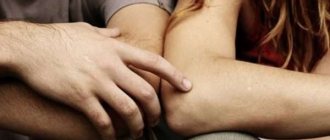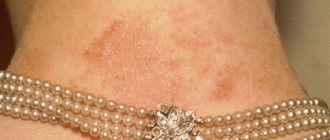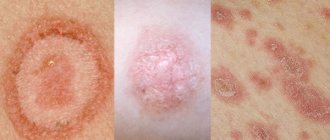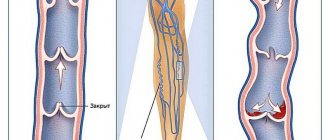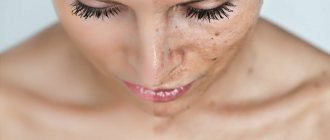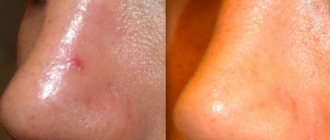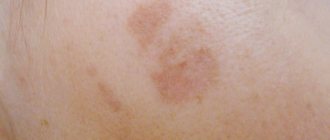White spots on the skin are not an independent disease, but can be a symptom of a dangerous disease.
We will talk about where white spots on the skin come from, how to find the cause of their appearance and how to treat them in this article. See photos of various diseases that manifest themselves as white spots.
How do white spots on the skin appear and where do they come from?
Leucoderma haunts women, men and children, regardless of age
White spots are a disorder of skin pigmentation, a pathological process that results in a decrease or disappearance of the level of melanin (coloring pigment) in the skin.
Doctors call white spots on the skin leukoderma, hypochromia, leukopathy, hypopigmentation or hypomelanosis.
The starting material for the formation of melanin is tyrosine (amino acid).
We either get tyrosine from food, or it is formed by an amino acid such as L-phenylalanine.
It is affected by pineal gland hormones or the enzyme phenylalanine-4 hydroxylase. This process is complex and is controlled by the nervous and endocrine systems.
If there is a malfunction in it, melanin in the cells stops accumulating and pigmentation is disrupted. This phenomenon is called skin dyschromia. White spots are one of the variants of dyschromia.
Leucoderma haunts women, men and children, regardless of age.
Also, white spots on the skin of various types can be a symptom of other infectious and non-infectious diseases. We'll talk about this in more detail below.
Preventing sun spots
7 recommendations to help you avoid getting white spots on your body after sunbathing:
- The most dangerous and intense solar radiation is at midday. To avoid sunburn, it is wiser to avoid tanning from twelve to one in the afternoon. At this time, ultraviolet rays have an aggressive effect on the skin. If it is not possible to stay at home at this time, you should wear a hat.
- Preference should be given to denser fabrics; transparent and mesh clothing transmits ultraviolet rays well. It is wisest to wear clothes made from natural materials. Cotton, chintz and other fabrics of natural origin work well.
- You should not wear synthetic clothing, it will be hot. The fabric can provoke the development of an allergic reaction.
- There is no need to ignore the properties of sunscreen and lipstick. It is wiser to give preference to products with a gel-like or light non-greasy consistency. They need to lubricate all exposed areas of the skin so that white spots do not appear on them.
- You should tan gradually. You don't need to stay in the sun for long on the first day. This applies even to those cases when a person is simply under a canopy. Long periods of time spent in direct sunlight will cause stains.
- No need to sunbathe with a wet body. This leads to skin burns and blemishes. When you have cooled down in the water, you need to carefully pat your skin with a towel and only then can you go sunbathing.
- You should wear sunglasses when sunbathing, because ultraviolet rays have a detrimental effect on the retina of the eye and provoke the development of various eye diseases. Also lubricate the delicate skin of the eyelids with sunscreen. It is wiser to purchase glasses with the required degree of eye protection in stores. Don't forget about your headdress.
Character of pigmentation
Based on the nature and characteristics of white spots on the skin, one can draw conclusions about the disease that caused them.
Here are just some descriptions and reasons:
- The color of the spot can be light pink or have a yellowish tint
A white spot with a red rim . A red rim around the spot is a sign of various problems in the body, infectious diseases or allergies. Another white spot with a red rim appears when a wound is healing, a burn, or as a result of serious stress. Spots with a red rim can occur due to ringworm, athlete's foot, trichophytosis, or mycosis contagiosum. The white color often appears due to plaque on the spot.
- Flaky white spots . The color of the spot can be light pink or have a yellowish tint. Often these spots are rough to the touch. The cause of such spots may be pityriasis versicolor, caused by a fungus. Less commonly, such spots are caused by psoriasis.
- Itchy white spots. These have a scaly surface, and in the cold season they can become inflamed. The diameter of the spots is from 1 to 4 cm, appearing on the arms and legs. The culprit is pityriasis alba. Dermatologists believe that pityriasis alba is caused by a fungus called Malassezia, which produces substances that block the passage of UV rays to the skin. Alba may develop in people with asthma, eczema or atopic dermatitis.
- Convex white spots . At the initial stage of development of lichen, all spots on the skin have a convex shape. The second reason is benign or malignant skin formations.
- Spots on the skin with white edges . The color may be pink, brownish or red, and the white edges are jagged. The appearance of spots is accompanied by itching and the desire to scratch the skin. These are also lichens, fungal diseases, streptoderma and dermatitis. Sometimes it's just a healing burn.
- White dry spots on the skin . They usually peel off. Here again, pityriasis versicolor or the more rare hypomelanosis are to blame. If they don't peel, get tested for vitiligo.
- Small white spots . If they are located in the form of a rash and have an uneven surface, mycosis is again to blame. Another cause of such spots is non-pigmented melanoma. This is a skin cancer that can be difficult to detect. Small spots with it have an irregular shape and clear boundaries, the hair located on such spots also turns white.
- White spots when pressed . Skin diseases and fungi are not to blame here. A symptom of a white spot is a phenomenon when a spot on the skin does not disappear for a long time after pressing with a finger. Causes: impaired sympathetic innervation or vascular insufficiency.
Whitish pigment spots
White pigment spots on the hands may appear for the following reasons:
- Genetic predisposition to decreased melanin production. This often happens due to the fact that a person spends a long time in direct sunlight. The consequences of this can be unpleasant and irreparable. Hypomelanosis cannot be completely cured. One of the effective measures to prevent the manifestation of symptoms is the use of sunscreen. It should be applied to the body before going outside.
- Photosensitivity of the skin increases due to taking medications. If a person takes various decoctions, tinctures or medications, then his skin becomes more susceptible to the effects of ultraviolet radiation. After a few hours, white spots form on it. It is important to read the instructions and description before using any medicine. These are often included in the list of contraindications. People whose work involves spending long periods of time outdoors in hot weather should be attentive to exposure to sunlight. It is important to check with your doctor about taking medications. Self-medication can only make matters worse.
- We should also talk about the solarium. About horizontal, because the position of the body rarely changes in it. Some areas of the skin receive excess sunlight, while others do not receive enough. So it turns out that due to strong radiation, an insufficient amount of blood reaches the skin, which leads to the appearance of spots on the skin. More often they appear in the pelvis and elbows.
Causes of white spots
Causes of white spots:
- Any inflammatory skin diseases;
- Endocrine diseases;
- Diseases of the central nervous system;
- Infections (syphilis, leprosy, white, red flat, scaly, multi-colored lichen);
- Consequences of inflammation (for burns or skin ailments accompanied by inflammation (eczema and psoriasis);
- Medicinal and toxic causes;
- Congenital. These are all forms of albinism (there are 10 in total), Bloch-Sulzberg melanoblastosis, tuberous sclerosis. They are often provoked by congenital pigment incontinence, Wolf syndrome, Waardenburg and Ziprovsky-Margolis syndromes;
- Immune causes (scleroderma, halo-nevus, systemic lupus erythematosus, vitiligo - with these ailments the immune system itself can destroy melanocytes).
Diseases
There are many diseases that can cause white spots to appear on the skin, and not all of them affect only the skin.
Here is a list of the most “popular” ailments:
- Vitiligo. The main symptom of the disease is milky white spots on the skin. They most often appear around the mouth, eyes and ears, on the arms and legs, in the groin area and on the buttocks. Their boundaries are clearly defined, the color may be bluish, and sometimes they have a pigmented outline or border. May be accompanied by dermatitis, baldness, inflammation of the retina, sweating disorders and skin sensitivity in white areas. Among the risk factors, one can note not only the reasons mentioned above, but also poor nutrition of the skin, its injuries and burns (can provoke disruptions in the immune system), liver and gastrointestinal diseases, and taking certain medications. Most patients begin to develop between the ages of 10 and 30 years. The causes of the disease are still being investigated:
- One of the reasons is called autoimmune failures. Thus, antibodies destroy healthy cells, including skin pigments. The connection between vitiligo and impaired immunity is evidenced by the fact that this disease often occurs in those who suffer from rheumatoid arthritis and systemic lupus.
- Another possible cause of vitiligo is problems with genetics.
- They can provoke vitiligo and malfunctions of the thyroid gland (goiter).
- Pityriasis versicolor. Fungal disease. It is caused by the round yeast-like fungus Pityrosporum orbiculare, the oval Pityrosporum ovale and the mycelial Malassezia furfur. All these are forms of one fungus and they can change freely into each other. They live quietly on human skin and do not harm it, and begin active activity only under certain conditions. The reasons for its appearance are insufficient body hygiene, a change in weather to warmer, and simply a person’s predisposition to fungal diseases. Most often occurs in young men and adolescents, and is more common in warm countries. The main symptom of pityriasis versicolor or pityriasis versicolor is white and scaly spots on the body that have an irregular shape. They arise due to the fact that fungi disrupt the functioning of melanocytes.
- Idiopathic guttate hypomelanosis . A benign variant of leukoderma, in which small depigmented spots appear on the body and face. Most often occurs in women over 50 years of age. The word “idiopathic” in the name means that the cause of the disease is unknown. But the fact that most often such hypomelanosis appears in adults indicates that one of its causes is photoaging of the skin. Confirmation of this can be found in statistical data: most sufferers from guttate melanosis are among those with fair skin (light type 1 - 3). Some dermatologists consider the cause of the disease to be histocompatibility antigens HLA-DR 8. Dermatologists do not rule out the hereditary nature of melanosis. The main symptom is small (up to 1 centimeter in diameter) porcelain-colored spots. They do not increase in size and have clear boundaries. The hair on the affected skin does not change color, which is how melanosis differs from vitiligo. The back of the lower leg is affected first, then the forearms, chest and upper back.
- Fungus on the skin. White spots appear due to fungal ringworms and thrush. They are usually accompanied by itching. There are a lot of fungi that live on our body (and inside it). But they can begin active activity in the following cases:
- with excess weight;
- after treatment with antibiotics;
- due to the habit of not drying the skin after bathing;
- for diabetes;
- in contact with animals and people sick with mycosis;
- when using things contaminated with mycoses;
- when wearing too tight clothes and shoes;
- with weakened immunity;
- with insufficient hygiene;
- during pregnancy.
- Pityriasis rosea . Aka Zhiber's disease. It is believed to be an infectious skin disease, but there is little precise information about its origin. The causative agent is unknown, but there is a version that it is a herpes virus. Little more is known about the contagiousness of the disease. Dangerous during pregnancy, as it can cause spontaneous abortion. Usually the disease begins with a couple of maternal plaques, which are distinguished by a bright pink color. After a few more days, light pink, almost white, rashes appear all over the body. In the center of the spots there is peeling, slight itching, a slight increase in temperature and enlarged lymph nodes. If left untreated, pityriasis rosea develops into a more severe form called Lichen annulare Vidal. After the rash resolves, as with any other skin disease, pityriasis rosea may leave white spots.
- Pigmentless nevus . It is also an intradermal mole in which there are not enough pigment cells. It is a skin neoplasm, and a benign one. It does not cause any particular concern, does not grow, and very rarely develops into a malignant neoplasm. Most often it occurs in children.
- Leprosy . Now the phenomenon is extremely rare. Doctors call it chronic granulomatosis. Caused by mycobacteria (Hansen's bacillus or mycobacterium lepromatosis). It affects not only the skin, but also the central nervous system, reproductive system, eyes, and larynx. What do the white spots have to do with it? They are the first symptom of leprosy. They are either too sensitive to stimuli (hyperesthesia) or not sensitive at all (paresthesia). After 2–3 days, this hypopigmentation disappears on its own.
- Syphilis . Here we are talking about syphilitic leukoderma. Treponema pallidum, as a carrier of syphilis, is transmitted not only through sexual contact. The rash with syphilis has its own characteristics. Usually spots appear with secondary recurrent syphilis. They are best seen in side lighting; they can vary in size, but their average diameter is about a centimeter. They are located in the neck, on the arms, on the torso, less often on the stomach, back or lower back. There is no itching, pain or other discomfort from them.
Pigmentless nevus
Idiopathic guttate hypomelanosis
Fungus on the skin
Leprosy
Pityriasis versicolor
Lichen Rosea Vitiligo
Syphilis
What diseases can be identified by hands?
Many hidden diseases can be easily unraveled by the condition of the hands. Moreover, many doctors use such diagnostic methods, and ordinary people classify them as mystics. The manifestation of symptoms on the palms or fingers is explained simply: there are many points on the hands that are systemically connected to the internal organs. They are the ones who react to the slightest changes. Do you want to know how to identify diseases on your hands? Pay attention to the following symptoms:
- If the skin turns yellow, you should pay attention to the functioning of the liver and bile ducts.
- Numbness in the fingers indicates diseases of the cardiovascular system and circulatory disorders.
- Roughness and itching are a reason to check the condition of the intestines.
- Swollen veins and an unnatural marble hue are signs of a nervous system disorder.
- A limb with bluish skin is a sign of mental disorder and neuroses.
- Elevation of the thumb is a possible symptom of gonadal disorders.
- Excessive sweating of the palms and peeling skin indicate dysfunction of the thyroid gland and a lack of vitamins.
By nail coloring
One of the factors for identifying hand diseases is to pay attention to the structure, shape and color of the nails. Healthy nails should be pink and nothing else. If you see that your fingertips appear blue and there are purple dots, there is a possibility of developing cardiovascular or pulmonary diseases. A matte blue tint indicates nervous diseases, and pallor is a symptom of anemia or vitamin deficiency.
When your nails suddenly turn yellow, most likely the problem lies in the gallbladder or liver. The presence of a greenish tint indicates coronary artery disease. Milky-colored nails often occur with cirrhosis, and unnaturally white or marbled nails with lesions of the adrenal cortex. Black dots under the nails are a sure sign of gangrene, diabetes, or thrombosis. If the nails not only turn yellow, but also begin to crumble, flake and change shape, it is worth treating mycosis.
According to the condition of the joints
You can learn a lot of useful things if you pay attention to the mobility, shape and condition of the joints. Too flexible hands and fingers indicate weakened muscle tone. If pallor or yellowness of the skin is added to them, it is worth checking the functioning of the liver and gall bladder. A characteristic crunch or squeak when turning the palm or bending the fingers is evidence of a lack of calcium in the body. If the fingers acquire an irregular shape, there is a risk of developing arthrosis.
If your hands begin to turn red, swelling in the joints or swelling appears, you should urgently consult an orthopedist or arthrologist - these phenomena may indicate the onset of rheumatic or polyarthritis. Pain between the second and third phalanx of the fingers indicates the imminent appearance of problems with the ankle and knee joints. Pain in small joints is a common companion for patients suffering from gout.
On the skin of your hands
The skin serves as a kind of barrier for humans. It prevents the penetration of bacteria, viruses and infections from the outside. When the integrity of the barrier is broken, various unpleasant symptoms occur: itching, flaking, redness, scabies, pimples. If you look closely at these signs, you can independently recognize this or that disease. Eg:
- peeling of the skin, itching, changes in the color and structure of the nails - mycosis or other fungal infection;
- thickening of the epidermis, the appearance of a flaky crust - eczema;
- acne, pustules - disruption of the functioning of any internal organs, often the digestive system;
- blisters that merge to form a large spot - urticaria;
- tight skin, changes in the shape of nails and fingers - scleroderma.
- rash of various types, protruding vascular network - toxic-allergic dermatitis.
Other situations
Sometimes white spots are not associated with endogenous diseases or skin diseases, or are rather indirectly associated with them.
Here are a few such cases:
- Sometimes pityriasis versicolor is to blame for the appearance of light spots after sunbathing, or less often - sunscreen
White spots after sunbathing . They can occur in areas of the skin that were once injured (scars, burns, etc.). Sometimes pityriasis versicolor is to blame for the appearance of light spots after sunbathing, and less often, it’s tanning cream (if it’s not distributed correctly). Other causes of white spots after tanning are due to a lack of melanin. Read above about the causes of this problem and contact a dermatologist.
- White spots during pregnancy . There are two reasons for their appearance. White spots on the legs may indicate problems with blood circulation and that the lower extremities need compression. The second reason is the same failure of the entire hormonal system that is typical for pregnancy. It also affects the production of melanin. Such spots will go away on their own after childbirth and they do not pose any danger.
- Light areas of skin after hydrogen peroxide. Peroxide is a good cosmetic product for getting rid of age spots, for cleansing the skin and fighting acne, but when used, an oxidation reaction occurs, which leads to a chemical burn and hypopigmentation. It's not easy to get rid of it. It will be easier to prevent such burns: It is better not to apply peroxide in its pure form (you can only apply it to individual pimples or dark spots).
- Keep it on your skin for no more than ¼ hour.
- Add softening ingredients (vegetable oils, honey, yolks) to masks with peroxide.
- After rinsing, be sure to soften the skin with a nourishing cream.
What do white stripes on nails mean?
Perhaps every person in his life has encountered the appearance of whitish stripes or dots on his nails. They can appear as a single manifestation, or they can completely cover the plates, not only on the arms, but also on the legs. Everyone is accustomed to treating them as a small cosmetic defect and does not pay attention to them. Meanwhile, white stripes on the nails can become a kind of signal from the body, indicating that it is feeling unwell. Also, white stripes can be a consequence of banal trauma to the plates. However, you should carefully consider the reasons for the appearance of stripes on the nails in order to help the body in time, if, after all, it is in this way “crying out” for help.
Where might they appear?
Where the white spots appear depends on the disease that caused the hypomelanosis.
Here are a few special cases:
- White spots on the stomach and back may indicate allergic reactions and skin diseases
white spots on the inside of the legs and arms appear due to lichen and fungal diseases;
- white spots on the legs, noticeable when pressed, are a sign of problems with blood circulation;
- Idiopathic guttate hypomelanosis begins with white spots on the lower leg;
- white spots on the stomach and back may indicate allergic reactions and skin diseases (psoriasis);
- white spots on the neck, called the necklace of Venus, are a symptom of syphilis;
- spots on the face (especially around the mouth) are a signal of the onset of vitiligo;
- white spots on the scalp - indicates focal albinism, which manifests itself in the appearance of white spots;
- white spots on the lips under the skin are signs of candidiasis, stomatitis, colds (caused by the herpes virus). White spots in the form of granules are diagnosed with Fordyce disease;
- small white pimples under the eyes - milia (popularly called millet) appear with increased sebum secretion;
- white spots on the palms appear more often with vegetative-vascular dystonia, vitiligo, leukoderma, partial albinism;
- white spots on the genitals are characteristic of inflammation and infectious diseases, such as candidiasis, papillomavirus, and also appear with decreased immunity, diabetes, and HIV infection.
- a separate white spot on any part of the body can indicate many skin diseases: syphilis, leprosy, mycosis.
Prevention
To prevent the formation of spots on the skin, doctors suggest following these recommendations:
- During periods of high solar activity, avoid being in the open sun from 11 a.m. to 3 p.m.
- use sunscreens containing safe zinc oxide formulations
- observe the drinking regime: calculate the daily norm using the formula 30 ml multiplied by body weight
- review your diet: eliminate excessively fatty, spicy, fried foods, reduce the amount of sugar and simple carbohydrates, introduce polyunsaturated fatty acids (olive and coconut oil, fatty fish), easily digestible sources of protein, fiber
- observe the work and rest schedule
- eliminate the source of stress
- go to bed no later than 23:00, sleep in a completely dark, cool room for at least 7-8 hours
- give preference to moderate physical activity: yoga, swimming, running, daily walking of at least 10,000 steps
At the first symptoms of disorders, it is recommended to abandon self-medication and consult a qualified dermatologist. The prognosis for patients with white spots on the skin depends on the underlying cause that caused the symptom. In most cases, the prognosis is favorable. To achieve the best result, it is important to remember to timely seek qualified medical help.
Diagnostics
Consult a doctor even if changes in the skin do not cause any discomfort or inconvenience.
Treatment is carried out by a dermatologist or dermatovenerologist, other specialists (endocrinologist, gastroenterologist, neurologist, immunologist, rheumatologist) are optional:
- The diagnosis cannot always be made only by external examination of the skin.
To make a diagnosis, a dermatologist will take a look at your medical history, examine your skin, and find out if you have recently taken (and what) medications or been in contact with (and what) chemicals. The diagnosis cannot always be made only by external examination of the skin.
- For a more detailed diagnosis, a blood test is needed , which can identify both an infectious disease and problems with the immune system (with systemic lupus, antinuclear antibodies are detected in the blood).
- Another type of diagnosis is carried out using a Wood lamp , which is used in special darkened rooms. This method allows you to differentiate infectious diseases (lichen, eczema) and non-infectious ones.
- To clarify the data, you can undergo a biopsy and genetic tests.
- , ophthalmologist, geneticist and cardiologist is required to make a diagnosis
Treatment
Often, treatment of white spots begins with treatment of the underlying ailment. If the reason is not very serious, they may go away on their own.
If leucoderma is of toxic origin, it is enough to stop contact with the substance that caused it.
First, complex treatment is always carried out using drugs and local agents.
The choice of such remedies depends solely on the reasons for the lack of melanin. Afterwards, normal skin pigmentation is restored and aesthetic defects are eliminated.
Medicines
They are prescribed depending on the cause of the appearance of white spots on the skin:
- For the treatment of lichen and other fungal diseases, the following tablets are considered the most effective: Lamisil. The active ingredient is terbinafine. It has a broad effect, stops the synthesis of stearins in fungi, which leads to their death. Contraindicated only in case of hypersensitivity to terbinafine. Price from 443 rub.
- Nizoral. It is also available in the form of tablets that effectively fight against mycoses. Stops the growth of the fungus, changes its cell membrane. Contraindicated for liver diseases, lactose intolerance and for young children (under 3 years). Price – from 790 rub.
- Orungal. Effectively fights against different types of lichens and fungi. Inhibits the key enzyme CYP 450 of fungi. Price from 2350 rub.
- Benzylpenicillin is effective against lichen and other skin diseases that cause the appearance of white spots. Contraindicated for epilepsy, hyperkalemia, arrhythmia. Available in the form of sodium or potassium salt. Price from 7 rub.
- Hydrocortisone (price from 150 rubles).
Ampicillin
Benzylpenicillin
L-phenylalanine
Hydrokartision
Lamisil
Nizoral
Oxacillin
Orungal
Prednisolone
Tyrosine
Each case of leukoderma is individual, so you may be prescribed the most unexpected medications.
PUVA therapy, UVB sessions
Both PUVA therapy and ultraviolet irradiation are light therapy methods.
They have proven themselves best in the treatment of the following skin ailments:
- vitiligo;
- psoriasis and parapsoriasis;
- dermatitis (atopic and seborrheic);
- lichen;
- lymphomas;
- many other rare skin conditions that can cause white spots.
PUVA therapy , also known as PUVA therapy, is a method in which diseased skin is irradiated using long-wave ultraviolet radiation.
This is combined with a photoactive substance (psoralens from the class of furocoumarins):
- You will notice signs of skin improvement after just 4 treatments.
First, you apply or ingest a psoralen product (take the drug with milk or bread).
- Then you go into the cabin and stay under the UV rays for several minutes.
- Another option is to take a psoralen bath a couple of hours after irradiation.
You will notice signs of skin improvement after 4 procedures, and remission after the course lasts from 18 months to 3-4 years. The course includes 20 sessions.
It also has a positive effect on the immune system. You can have from 2 to 4 sessions per week, and have a new consultation with a dermatologist every 14 days.
Contraindications:
- Hypersensitivity to psoralen;
- Diseases in which sensitivity to light develops (lupus erythematosus, porphyria);
- Melanoma;
- Pregnancy;
- Heart diseases.
UFO (ultraviolet irradiation) is another method of physiotherapeutic treatment. Its work is based on the fact that certain atoms and molecules selectively absorb light energy.
The molecules in the tissues are then in an excited state. This is how photochemical processes are launched in RNA, protein and DNA molecules.
Indications:
- For therapy to be successful, before starting it, the doctor will determine your biological dose of UV rays.
vitiligo;
- pyoderma;
- seborrhea;
- psoriasis.
For therapy to be successful, before starting it, the doctor will determine your biological dose of UV rays. The course lasts from 10 to 20 irradiations. They are held once every 2 days.
Contraindications:
- predisposition to bleeding;
- neoplasms (malignant only);
- tuberculosis (in the active stage);
- thyrotoxicosis;
- hypertension;
- exacerbation of intestinal and stomach ulcers;
- blood diseases (systemic);
- atherosclerosis (coronary vessels and arteries of the brain);
Procedures are carried out with caution for acute diseases of the skin, nasopharynx and inner ear, for skin tuberculosis and for wounds caused by anaerobic bacteria.
Treatment of white stripes on nails
To get rid of the defect, you first need to find out what the white stripes on the nails mean. If the causes are caused by endogenous factors or severe changes in the functioning of the body, then serious long-term treatment will be required, aimed at eliminating the disease or maintaining the body. A complete examination of the body, tests, scrapings from the nail plate are necessary, on the basis of which the doctor will prescribe the necessary treatment or supportive therapy.
In mild cases caused by an unbalanced diet or under the influence of exogenous factors, firstly, normalizing the diet, as well as simple folk remedies, will help. As for traditional medicine, they will help minimize the appearance of white stripes and reduce the risk of further formation of a defect due to the activation of the body’s protective properties. But final getting rid of white stripes on nails is possible only when the plate grows completely.
However, you should consider the methods that traditional medicine offers:
- Bath with sea salt. It will not get rid of white stripes, but it will help strengthen the nail plates and in the future they will be more resistant to mechanical damage. Very strong saline solutions will be effective - 5 tbsp. l. sea salt per 0.5 l. warm water. It is enough to carry out such “bathing” once a week for 20 minutes.
- Oil rubbing. A mixture of olive oil and lemon juice (10 ml of oil and 5 drops of lemon juice) must be rubbed into the plates daily using a cotton pad. This procedure will help strengthen your nails, protect their delamination and give a beautiful glossy shine. But the main thing is that such rubbing will help reduce the white streaks, but they cannot completely remove them.
- Vitamin-iodine rubs. A mixture of almond oil (1 tsp), liquid vitamin A (5 drops) and iodine solution (5 drops) should be rubbed into the nails daily. This product strengthens the nail plates, reduces the severity of white stripes, and also promotes rapid nail growth, so you can quickly get rid of the annoying defect.
Physiotherapy
Kinds:
- Do the procedure daily or every 2 days
The simplest physiotherapeutic method is heliotherapy . It's just a tan under the southern (or just summer) sun. Regular tanning under the sun also activates melanin synthesis. It is important to complete a whole course of sunbathing, that is, from 12 to 24 trips to the sea or to the river. Contraindicated in patients with cancer.
- Electrophoresis of copper . It mitigates side effects after PUVA and UVB. Complete the procedure daily or once every 2 days. The duration of electrophoresis is ¼ hour.
- Darsonvalization . The skin is exposed to pulsed current (frequency and voltage are high, strength is low). It is actively used in the treatment of vitiligo, psoriasis, eczema, dermatitis and many other skin ailments. Contraindicated in cases of cancer, skin tumors of any nature, epilepsy.
Skin graft
This method is recommended for vitiligo, when areas of hypomelanosis become too large and cannot be corrected.
Skin grafting can be:
- To carry out the transplant, the skin is cut off using a dermatome, the flap is immediately transplanted to the desired area and sutured
autotissue, when the patient’s healthy skin is used (for vitiligo - not the best option);
- allotissue – the skin of immediate relatives is used;
- cellular is a good option for vitiligo. It uses individual cells created in the laboratory.
To carry out the transplant, the skin is cut off using a dermatome, the flap is immediately transplanted to the desired area and sutured.
Another operation, melanocyte transplantation, is also gaining popularity.
It is carried out if the disease is stabilized and the spots have not grown for the last six months.
For transplantation, healthy melanocytes are taken from the skin on the buttocks (or other areas of the skin not affected by vitiligo), converted into a cell suspension and injected into the depigmented area, previously treated with dermabrasion or laser.
A special bandage is placed on top. Repigmentation occurs after 2–4 months.
There are several requirements for melanocyte or skin transplantation:
- you should not be anemic;
- the level of total protein should be below 60 g/l;
- protein coefficient level is greater than 1.
Ointments, shampoos, soaps, creams
This is not the most effective way to deal with white spots, because the problem is hidden much deeper than on the surface of the skin. But they can also help.
It is best to use ointments when dealing with spots caused by lichen or mycosis. If you are prescribed Nizoral, Orungal or Lamisil tablets, it is recommended to enhance their effect with similar ointments. The same goes for antibiotics.
Here are a few names of ointments that dermatologists prescribe for leukoderma of various origins:
- Methylpred (price from 350 rubles), alklometasone (price from 320 rubles). These are glucocorticoids in ointments. Can be used for vitiligo.
- Melagenin. A popular drug for the treatment of vitiligo. Available as a lotion. The basis of the product is human placenta extract. When using the product, the repigmentation process is accelerated, the skin absorbs ultraviolet rays and the formation of melanin is stimulated. A positive effect is also observed in cases with loss of pigmentation after psoriasis or burns and wounds. It is also effective for eczema and psoriasis. Price from 4400 rub.
- Betamethasone. A glucocorticoid agent that will be effective for both vitiligo and fungi. Price from 176 rub.
- Clotriamzole. Ointment with a wide spectrum of action. It will help get rid of causes of white spots such as lichen and fungal diseases; it is also effective for eczema and psoriasis. Price – 97 rub.
- Irunin. An antifungal agent with the active substance itracanazole. Inhibits the membranes of many fungi. Price from 352 rub.
Afloderm
Betamethasone
Irunin
Clotrimazole
Melagenin
Metipred
What skin diseases can be confused with vitiligo?
When you notice white spots on your body, you need to see a specialist (doctor). The sooner you take action, the more successful it will be in the future:
- If you have spots on your head, this means that you have pityriasis versicolor. The fungus infects the surface of the skin and, accordingly, the scalp. At this time, the enzymes of the fungus prevent the production of melanin, and this causes the skin to become pink at the very beginning, and after that the characteristic whiteness appears.
- In the case of ringworm, itching occurs and scales and skin prominence appear. Also, the diseases are distinguished by a certain fungal nature: this is clarified through certain research.
- Vitiligo is often confused with a type of non-contagious lichen . In this case, drug treatment is prescribed.
- Leukoderma (cosmetic defect) is also called the “ necklace of Venus ” and is caused by the manifestation of syphilis (mainly secondary). In some cases, it appears on the arms, on the back and even on the armpits. Lightened areas up to a centimeter in diameter are not capable of causing any physical discomfort, but they can remain on the body for several years. In this case, treatment must be prescribed by a venereologist.
- In the lists of various cases, suspected skin diseases can manifest themselves in the form of abrasions, burns or cuts . Pigmentation in this version takes quite a long time to rehabilitate, ranging from several months.
What is vitiligo disease?
White spots appear on the skin, usually shaped like an oval or a circle.
In such areas, melanin ceases to be produced for various reasons. As a result, you can get a sunburn, since by losing melanin in a certain area, the area becomes unprotected from the effects of ultraviolet radiation. Milky white or pink spots appear throughout the body, but often on the arms, groin, face, and elbows. They are usually very noticeable on dark skin, especially in the summer, when you sunbathe, the spots do not tan or become darker. No discoloration was detected on the palms and soles.
Vitiligo pigment spots can form on a specific area of the body, in which case the disease is localized. Or it is generalized, when they flow in and the depigmented zone takes over a significant part.
If you have the most severe degree of this disease, your skin will become completely discolored (like an albino). The sensitivity of the skin remains as it was, there is no pain. If the white spot is located in the area of the head (hairline), then the hair in this place loses its color. In other cases, sweat and sebum secretion is disrupted in the infected area, the skin loses its sensitivity, and solar dermatitis occurs.
This disease affects about two percent of people. It mainly develops between the ages of ten and thirty; it does not occur in older people. Women and men get sick equally. In one out of ten cases, the disease can be inherited.
In the list of cases, vitiligo is accompanied by various types of skin diseases: focal baldness, psoriasis or lichen planus.
Methods for treating vitiligo disease
You should know and understand that an absolutely complete cure is possible only in cases where concomitant diseases have been eliminated.
Basically, a dermatologist chooses a special individual treatment regimen in each specific case. The form of the disease is also taken into account - generalized, universal or localized, and other factors that are revealed through appropriate studies, the presence of melanocytes in the spots.
If it has already been possible to identify the cause, then there are other disorders in the health of the body, the treatment of vitiligo disease begins mainly in this way. Treatment of white spots on the body can be complex, which means that some kind of therapy is prescribed to quickly restore the appearance of the skin.
There are a lot of ways to treat vitiligo, and new ones are constantly appearing. In the list of cases, white spots disappear on the skin by themselves, or during the treatment of concomitant diseases.
Treatment with Melagenin +
It is still possible to achieve the desired effect (success) when using this drug from sodium chloride and an alcoholic extract of the human placenta. The effect becomes more noticeable after just seven days of treatment, and after six months we can already hope for a more significant process.
This drug is applied externally to the stains themselves, rubbing is not required, you just need to wait until it is all absorbed. It can also be used simultaneously with cosmetics.
Elimination of white spots using photochemotherapy (PUVA therapy in other words)
This method of treatment is still used today. At the beginning of the procedure, the patient takes a special drug, a certain photosensitizing substance that increases the sensitivity of the patient’s skin to light, after which he is placed in a special solarium, where his body and, accordingly, problem areas are exposed to ultraviolet radiation. Mainly used to increase sensitivity are Puvalen, Oscoralen, Psoberan, Melagenin, Metoxalen and Psoralen.
Photochemotherapy is more effective for people with dark skin. In such cases, half may succeed. The treatment lasts for sixty days every other day. If improvements are noticeable, then after ninety days the therapy will be repeated again. Three or four courses are usually enough to achieve the goal.
Phototherapy is not addictive in patients and can be used repeatedly, which cannot be said about a photosensitizing agent, since it has some side effects.
Therefore, to treat a disease such as vitiligo, narrow-spectrum ultraviolet radiation is used, in which taking the necessary drugs to increase the skin’s sensitivity to light radiation becomes optional.
A prerequisite for using this method is the complete stop of the formation of new pigment spots on the skin. You also need to choose the dosage of treatment very correctly.
Treatment of vitiligo with laser
When using a helium-neon laser, the cure time for vitiligo is significantly reduced. The principle of application is somewhat similar to PUVA therapy, however, the skin is exposed to a more precise dosage and stronger radiation. There is a possibility of removing very old spots on the body that have remained on the skin for many years.
The only disadvantage of this method is the risk of burns and the very high cost of treatment.
In the treatment of vitiligo with subsequent preservation of the melanocytic layer, special excimer laser therapy is indicated.
Skin graft
The method of treating this cosmetic defect is considered to be transplantation of a healthy area of skin in place of depigmented areas. This method is mainly used to remove minor stains.
The method makes it possible to achieve faster results if previous treatment methods did not help and did not produce a significant result. Often, the transplanted tissue loses pigment, so the tissue for transplantation, or you can also call it donor tissue, is subjected to special PUVA therapy. This is necessary so that the donor tissue can stimulate the production of a certain pigment and take root better.
The course is prescribed with zinc preparations, vitamins E, B12, B9, C, and copper, because they are deficient in the human body. For more effective restoration of melanocytes, immunostimulants are mainly prescribed.
Whitening healthy skin
If the treatment processes with other methods did not produce any results at all, and the skin at that moment became much lighter than usual (70% lighter), then there is only one option left - whitening the remaining skin by destroying healthy pigment cells.
Cytotoxic drugs are used that trigger the self-destruction program of melanocytes.
This is done in order to restore a uniform skin tone, because it is very difficult to hide such imperfections with cosmetic substances.
Folk remedies
Also not the most effective method of dealing with white spots on the skin. But in combination with other measures they will be beneficial. Just remember that herbs and seeds are also medicines and you need to treat them like you would take regular pills.
Thus, traditional medicine offers its vision of the treatment of vitiligo:
- Rub the stains with sulsen anti-dandruff paste . It's better to take 2%. Sulsen soap works even better. The spots disappear in a few days.
- Mix black pepper in equal proportions with soda and rub regularly into the whitened areas of the skin.
- Whitened areas can also be lubricated with birch tar . We carry out this procedure twice a day for exactly a month.
- the marsh duckweed (5 g), place it in a dark vessel and fill it with 50 ml. vodka. Leave for 7 days in the dark and at room temperature, filter through gauze and drink 20 drops three times a day, pouring ¼ glass of water.
- In equal proportions, mix the pericarp of the walnut with its leaves . Pour in 10 parts of vodka. Leave for 1/3 month and smear areas with no pigmentation maximum twice a day. Treatment lasts a couple of months. Use a protective cream after the tincture.
There are also recipes in folk medicine that allow you to get rid of lichen and infections:
- Away from roads and industrial areas. zones we collect celandine (stems, flowers, leaves). Grind and mix a glass of raw materials with a glass of sugar. Place on gauze and wrap. Now heat the yogurt so that you get cottage cheese and place it in a large jar. We also place the celandine in gauze here. We wait a month, every day we remove the film and make sure that the bag does not float up (it’s better to press it down). Strain and drink 20 ml three times a day.
- Sunflower petals (freshly picked) are steamed in boiling water and applied to places where there is lichen. We use it daily.
- Wipe yourself with apple cider vinegar . It's better if you do it yourself too. To prepare, chop apples (one bucket) and pour in the same amount of boiling water, and add 20 g of sugar on top. When it has fermented (this will happen in 14 days), strain and let it brew for another 14 days.
- a couple of tablespoons of calendula flowers , place in a small glass jar and pour half a glass of vodka. Cover tightly and wait a week. Use for lubrication once a day. A tincture from a pharmacy is also suitable.
Proper nutrition
White spots often appear due to problems with metabolism and the gastrointestinal tract. This can be corrected by changing your diet.
You can also stimulate the production of melatonin with proper nutrition. When treating white spots of any etiology, do not forget about the role of nutrition in their therapy.
With vitiligo, the body needs tyrosine.
You can find it in the following products:
- Traditional medicine for white spots recommends adding onion juice and garlic to all your dishes
sea fish;
- milk and everything that is made from it;
- seafood;
- meat and liver;
- all legumes;
- vegetable oils;
- eggs;
- buckwheat, millet and oats;
- carrots, tomatoes, cauliflower, radishes, pumpkin, spinach, beets, avocado, parsley;
- banana;
- grapes, blueberries, raisins;
- pumpkin, sesame, flax, sunflower seeds;
- pistachios, hazelnuts and almonds.
Traditional medicine for white spots recommends adding onion juice and garlic to all your dishes as a means to fight fungi and helminthic infestations and to strengthen the immune system.
Be sure to take vitamin and mineral complexes as an addition to a proper diet.
Do not abuse coffee, sweets and alcohol.
Eliminate from your diet everything that could even theoretically cause an allergy. Observe how your skin behaves without provocateurs.
Take action!
If you find white spots on your skin, you don’t need to wait for them to disappear on their own:
- Go to a dermatologist or dermatovenerologist and immediately begin examining your skin, body and blood. Sometimes such spots are only the first sign of an impending serious illness, and if you take care of it in a timely manner, then there is a chance that you will defeat it and be left with clear skin and a healthy body.
- Start getting rid of the problem by treating the ailment that caused it, otherwise you will not get rid of the stains.
- Be prepared for the fact that in some diseases, white spots are unlikely to be completely eliminated. And if this aesthetic flaw worries you so much, complete a makeup course and learn how to disguise your problem. A tattoo or self-tanning will also help with this.
White spots on the skin are called by different names, and they have many causes. And while some of them pass quickly, others are completely impossible to get rid of. But this does not mean that you do not need to fight for your health and clear, beautiful skin.
How to cure?
First you need to carefully study the problem of the appearance of stripes. Since white streaks can be caused by external factors, it is advisable to eliminate them from your daily life or minimize their impact on your body. Try to use rubber gloves more often when washing dishes and cleaning the house using household chemicals. Use creams that protect the nail plate. Also, after cleaning and other similar procedures, you need to rub sea buckthorn oil into your nails.
If such nail care does not save you from the appearance of white stripes, then the reason lies elsewhere. To correctly determine the treatment for your nails, contact a dermatologist or his colleague, an onychologist. An onychologist is a doctor who specializes in the treatment of diseases of the nail plate. A specialist can determine an accurate diagnosis only by looking at the biochemical results of the research.
If experts identify the cause of the appearance of white stripes as a fungus on the nail plate, then an effective treatment method will be the use of a special antifungal nail polish. The varnish is used together with the use of other medications. Antifungal varnish must be used within 6 months.
In addition, you can cure white stripes using folk recipes. When treating nails with the traditional method, it is also necessary to make therapeutic masks. A mask based on olive oil, lemon juice and tea tree extract is considered very effective. The mask will work if you take the procedure every day for three weeks.
One of the effective remedies is garlic. At the same time, garlic can be used separately or as part of a healing mask. In the first case, the steamed nails must be rubbed with half of peeled garlic.
The recipe for a garlic nail mask is also simple: you need to crush it and grind it into a homogeneous mass, while adding essential oil to the composition.
The garlic mask should be kept on the nails for 60 minutes. It is recommended to repeat the procedure every day until the white stripes disappear from the surface of the nail plate.
Although white stripes on nails are a problem for our health, the problem can be solved. So if you see horizontal or vertical white stripes on your nails, then follow our advice and be healthy.
